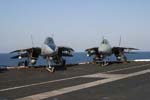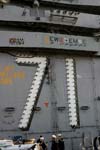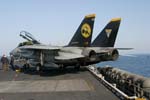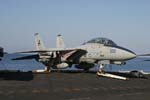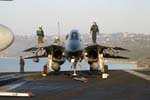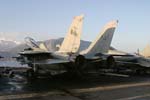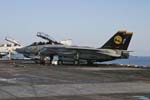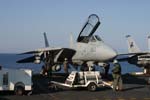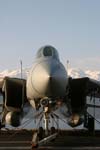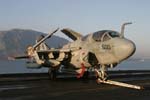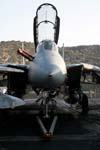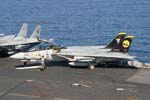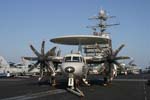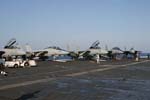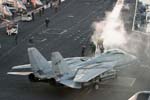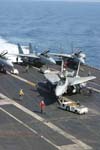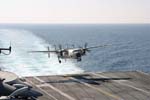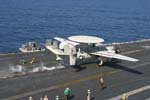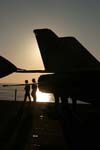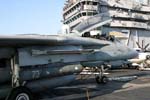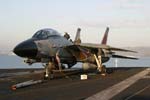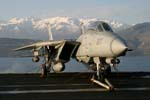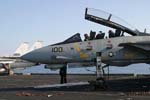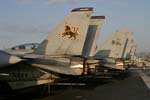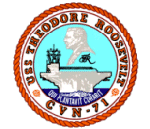  |
|||||
| Author:
Joris van Boven / Sentry Aviation News Photography: Author |
|||||
By the time this report is published, the last two squadrons of Grumman F-14 Tomcats will have flown off the deck of the US nuclear aircraft carrier, CVN-71 USS Theodore Roosevelt, and landed at the US Naval Air Station Oceana, near Norfolk, Virginia; the carrier itself was due to have berthed at her homeport of NS Norfolk, not far from Oceana at the end of a seven-month long voyage. |
|||||
The two squadrons of Tomcats made a mass flypast over Oceana (CVW8 Homecoming) not only to mark the end of the cruise, but also, in a way, to say farewell to the aircraft type which has since been withdrawn from US naval service. Some F-14s, however, are still operational in Iran with the Islamic Republic of Iran Air Force. |
|
The USS Theodore Roosevelt went into service on October 25, 1986 with enough nuclear fuel in its two reactors to theoretically remain at sea for 20 years. Her top speed is believed to be above 30 knots, she boasts a flight deck that is 320 metres in length and from the bottom of her keel to the top of the highest mast is 70 metres. Under the command of Captain John R. Haley, who has 5,500 men and women serving under him, the carrier began what has been termed the “Last Cat Standing Cruise” on September 1, 2005 alongside CG-56 USS San Jancinto, DDG-75 USS Donald Cook, DDG-79 USS Oscar Austin, F101 SNS Alvaro de Bazan, T-AE 34 USS Mount Baker and T-AO 196 USS Kanawha. |
|
|
During the following months, the two F-14 squadrons on board (VF-213 Black Lions and VF-31 Tomcatters) flew a combined total of 6,876 hours which included 1,163 combat sorties. The Tomcats’ final combat mission was flown on February 8 and was led by Capt. W. Sizemore, Commander of the carrier air wing. The complete CVW-8 wing flew 19,362 hours over 5,412 missions during the cruise. Most of the combat missions were flown from the carrier, although some were also made from land bases in the Gulf area. |
The USS Theodore Roosevelt was eventually replaced in the Persian Gulf by America’s latest nuclear carrier, CVN-76 USS Ronald Reagan, which was on its first operational cruise. As the Theodore Roosevelt started its return voyage to the United States, it called in at Marmaris , in Turkey, where I and a number of other journalists, joined the ship for a 36 hour voyage to Souda Bay, Crete, during which time we were able to sample what life is like on this giant ship. As I write this on board, we are underway in the Mediterranean; it is hard to believe, judging by all the activity that this is a home-going trip. |
|
The trip was announced, five days before the starting date, by U.S. Navy 6th Fleet PAO as a 24 hour stay onboard and for that stay, all invitees had to be at the port of Marmaris (in Turkey) on Monday 20th February 2006 at 1800. The trip would finish at Souda Bay, Crete on the morning of Wednesday 22nd. From the list of invitees, two other Dutch people would be traveling the same way and we decided to travel together. A tedious job was started to get a set matching flights fast, preferably starting and ending on one and the same airfield. In my case it was a flight to Turkey (from Düsseldorf to Istanbul connecting to Dalaman, followed by a taxi to Marmaris) on Sunday and a return flight on Thursday from Chania (Crete) to Athens, Thessaloniki and Düsseldorf. Fortunately all my flights could be booked at the same time, securing the travel in and out. |
After a good trip to Turkey and a good night’s sleep in a hotel in Marmaris, the Theodore Roosevelt was clearly visible in the bay of Marmaris on the morning of the 20th. Until 2200 hours, the day was spent at a compound that supplied breakfast/lunch/dinner for the sailors of the Roosevelt that went ashore. The Public Affairs Officer collected our group of eleven, for a boat trip out to “The Big Stick” (the Roosevelt’s nickname) at night. After sleeping (not!!) in a tiny 3-person room, the next day was announced as the final full flying day of the cruise. |
|
There is flying going on most of the day and sometimes well into the night as well. Small wonder, when one considers all the aircraft on board. In addition to the two squadrons of F-14D Tomcats, there are also two strike fighter squadrons of McDonnell-Douglas F/A-18Cs - VFA-15 Valions and VFA-87 Golden Warriors. There is also VAW-124 Bear Aces airborne early warning squadron equipped with the Grumman E-2C Hawkeye. This cruise was a milestone for this squadron as it was the first time that the aircraft had been flown operationally with the new eight-bladed NP2000 propellers. The Grumman C-2A Greyhound aircraft equip the fleet logistics support squadron, VRC-40 Rawhides Det 1, and the Lockheed S-3B Vikings of the sea command squadron, VS-24 Scouts, were on their last deployment. This squadron is due to be disbanded within a matter of weeks and all Vikings will be withdrawn from US service by mid-2009. The electronic attack squadron, VAQ-141 Shadow Hawks are equipped with the Grumman EA-6B Prowler and the sole anti-submarine helicopter squadron, HS-3 Tridents, are equipped with Sikorsky SH-60F & HH-60H Seahawks. |
The big day (Tuesday 21st) started with a briefing by the PAO about the dos and don’ts. No catwalk photos, no photos near Cat 1 and 2 and definitely NO FLASH during night flying. All cameras that flashed during night flying would end up at the bottom of the sea, no discussion. The flightdeck was visited to see the flight preparations for that day. With the protective white coat and the cranial (head, ear & eyes protector), the first flight operations could be seen from the flight deck and, without the protective gear, from 10 stairs above on Vultures Row. On the flight deck the catapult launches were photographed, standing only a few meters from the roaring aircraft. Similarly, the landings could be witnessed near the LSO platform, a matter of a few yards from the aircraft, and again from Vulture's Row. |
|
|
All through the day, there were several cycles (launches and recoveries) and each time the big ship moved graciously her nose into the wind before the flying activities would start. Tomcats, Hornets, Prowlers, Vikings and Greyhounds all flew that day, while the plane guard Seahawks of HS-3 flew alongside. During the afternoon recovery, three VAQ-141 EA-6Bs that had been operating from a forward operating location returned after USS Ronald Reagan arrived on station and VAQ-139 could take over their role. |
Near sunset, the night flying activities were started. Several launches during sunset on a darkening flightdeck occurred yet when the sun finally sank below the horizon, the recoveries took place in total darkness. Only some small lights on the flightdeck and on the island remained lit. The pilots all landed safely in this very, very, very dark environment. The next day (Wednesday 22nd) the USS Theodore Roosevelt pulled into the port of Souda Bay (Crete). Prior to the disembarkation, an hour of deck-shot photography was allowed. At sea, there is only blue sky and blue water as background available so the snowy mountains of Crete gave a very special background to the aircraft on deck. |
|
However, this cruise was all about the mighty Tomcat’s final fling. The Grumman F-14 Tomcat began operations some 30 years ago with VF-1 and VF-2 as a fighter/interceptor equipped with the AIM-9 Sidewinder, the AIM-7 Sparrow and the AIM-54 Phoenix missiles. Tasked with fleet defence and air superiority, the Tomcats were upgraded to become the F-14A+ (re-designated as the F-14B), and with later upgrades and modifications, became the final version, the F-14D. The aircraft was later assigned a new task, namely that of a bomber and it was not long before their crews nicknamed the aircraft the “Bombcat”. Its new ground attack role was made possible by the use of the low altitude navigational and targeting infrared for night (LANTRIN) system and the wing mounted tactical air reconnaissance pod system (TARPS). Installed in a dual “chinpod” under the nose are a Television Camera System (TCS) which is the same as that used in the F-14A and an Infrared Search and Track (IRST) system which allows for passive identification of targets at ranges in the region of 200km. |
A new feature was added last December called ROVER (Remotely Operated Video Enhanced Receivers) which enabled the Tomcats to take real-time video images of the battlefield and broadcast them back, in real-time, to suitably equipped ground forces. Within days of a development team boarding Theodore Roosevelt in early December 2005, both VF-31 and VF-213 had a complete ROVER capability. The Black Lions have already begun the transition to the F/A-18F Super Hornet, while the Tomcatters continued to operate the F-14D aboard the USS Theodore Roosevelt during the ship’s readiness and sustainment period. The squadron is then due to begin the switch over to F/A-18E Super Hornets in October of 2006 and the carrier will be temporarily withdrawn from service for a major refit which is expected to take about three years to complete. |
|
The resting places for the last operational US Navy F-14s are as follows:
|
||||||||||||||||||||||||||||||||||||||||||||||||||||||||||||||||||||||||||||||
Special thanks must go to Lt Kuebler, Lt Cole and Lt Servello of the US Navy, without their assistance this article would not have been possible. OuterMarker would also like to thank Dave Brown for his assistance with the locations of the last ever operational F-14D Tomcats in the US Navy. |

